Dr. Andrew Niehaus of Ohio State University says environmental conditions and genetics are the biggest factors in risk for foot diseases. Some animals have poor foot/leg conformation that puts stress on the feet or weaker hoof horn. “Those animals are probably never going to have strong, healthy feet compared to other cattle,” he says.
“Nutrition also plays a role. Protein, vitamins and minerals are important for normal hoof growth and strength,” says Niehaus. “Deficiencies can result in poor growth and weak horn. Energy metabolism is a factor; too much concentrate in the diet can cause laminitis.
Even though cattle may not develop severe clinical signs like a horse, inflammation of the laminae makes the feet sore. Affected cattle have mild lameness and produce poor-quality hoof horn, which leads to problems like white-line disease, sole ulcers, abscesses.”
Environment plays a big role. Abrasive or sharp surfaces like concrete or gravel can lead to hoof injuries or abnormal wearing. Boggy conditions are also damaging; excessive moisture softens hoof horn and makes it more prone to injury.
Foot rot
“Warm, wet environments create ideal conditions for bacterial growth. There may be anaerobic bacteria in the mud, such as Fusobacterium necrophorum and Porphyromonas levii, the two commonly implicated bacterial pathogens that cause foot rot. With softened skin (easily scraped or punctured) and hoof horn, bacteria gain access,” Niehaus says.
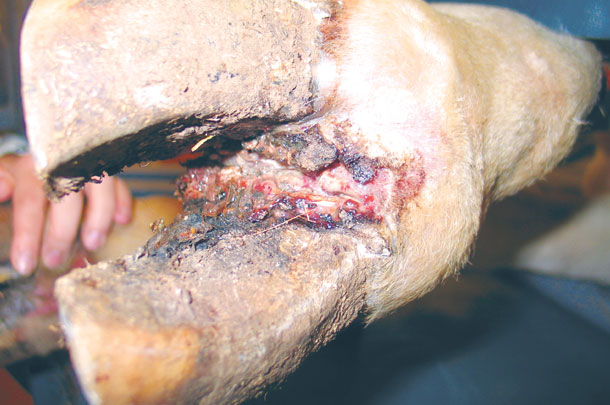 “Infection/inflammation causes heat and swelling. Fusobacterium necrophorum causes necrosis – dead and dying tissue and inflammation of surrounding tissue, with pain and lameness. Dead tissue is an anaerobic environment suitable for continued growth of these bacteria.”
“Infection/inflammation causes heat and swelling. Fusobacterium necrophorum causes necrosis – dead and dying tissue and inflammation of surrounding tissue, with pain and lameness. Dead tissue is an anaerobic environment suitable for continued growth of these bacteria.”
The good thing about foot rot is: It generally responds to treatment. “Some forms tend to be more virulent but, typically, it responds quickly, if we catch it early. Penicillin works well for anaerobic bacteria, and oxytetracycline is broad-spectrum and usually very effective, administered systemically or locally,” says Niehaus.
“If untreated, however, infection may spread to the tendon sheath or joint. Then the prognosis (and our ability to treat it) dramatically decreases,” he says.
White-line disease
“The white-line area is the junction between the bottom of the sole and hoof wall. This tends to be a weak spot – softer than the rest of the hoof and more readily penetrated, especially in wet conditions,” he says.
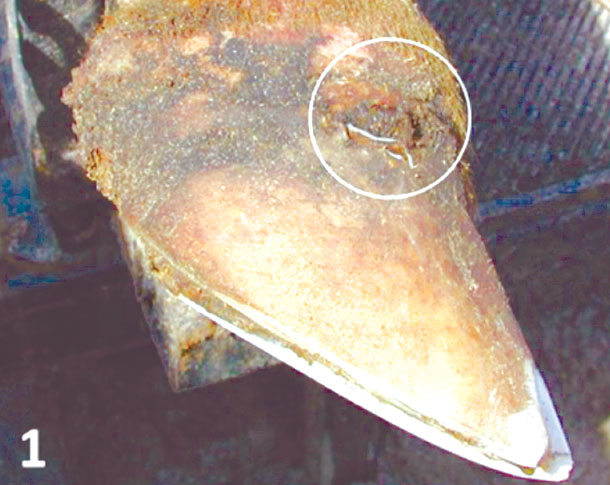
White-line disease is also common when cattle are fed a lot of concentrates (such as bulls on test or show animals). This area of the foot becomes softer. “By itself, white-line disease may not be a problem, but can lead to undermining the sole. This can lead to abscesses, or foot ulcers if the abscess ruptures out, or joint infection,” Niehaus says.
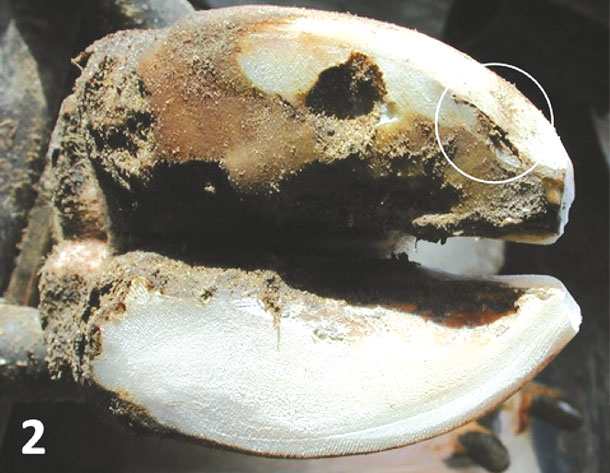
If white-line disease is noticed when the foot is being trimmed or examined, it should be cleaned out with a hoof knife. “Otherwise, it might be the start of something more serious,” he explains.
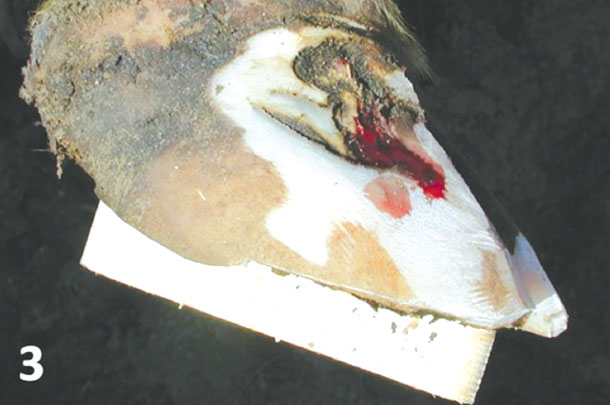
Hairy heel warts
“We think this disease is caused by a spirochete bacteria. It is contagious and can cause severe lameness. Usually these lesions are just in the heel area. They can be extensive or as small as a dime but are very painful, causing severe lameness,” says Niehaus.
“I’ve seen cases that covered the whole back of the hoof. Sometimes they are small depressed lesions. Others are very proliferative, looking like granulation tissue (proud flesh) protruding outward,” he says.
“This disease also responds fairly well to antibiotic treatment. Usually, I treat topically with oxytetracline spray, footbaths or soak a bandage with oxytetracycline and keep that in contact with the lesion for a few days,” says Niehaus.
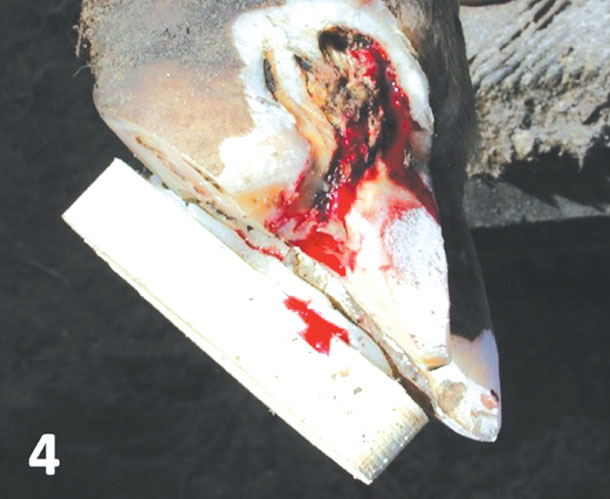
Septic arthritis
“At our hospital, we deal with many cases of deep digital sepsis (septic arthritis of the coffin joint) which can be due to advanced foot rot infection or infected sole ulcers that spread up into the joint. These have poor prognosis for good recovery without surgical therapy. This is costly, however; the recommended treatment depends on the owner’s expectations and goals,” he says.
“Facilitated ankylosis (fusion of the joint) is recommended for valuable breeding stock. It’s not a fast turnaround like treating early foot rot or hairy heel warts, where you give a few days’ treatment and the animal is sound again. Facilitated ankylosis usually takes three to four months of convalescence.
It involves drilling out the joint, flushing to resolve the infection, then immobilizing the joint after the infection is resolved. We use a cast to keep the foot/leg rigid and immobile. Once it heals, and the bone is fused, it’s not painful anymore,” he explains.
“A salvage procedure to enable a cow to finish raising her calf is to just amputate the affected toe. This is cheaper and faster than fusing the joint,” Niehaus says. There is risk the opposite toe will break down because of excessive weight-bearing so, for long-term soundness, facilitated ankylosis is a better option.
Hoof cracks
Dr. Jan Shearer, Iowa State University, says vertical wall cracks are more common in beef cattle than dairy cattle, but horizontal cracks are common in all cattle. “Most vertical cracks occur in the outer claw of the front feet but rarely cause lameness. When they do, they can be difficult to fix,” he says.
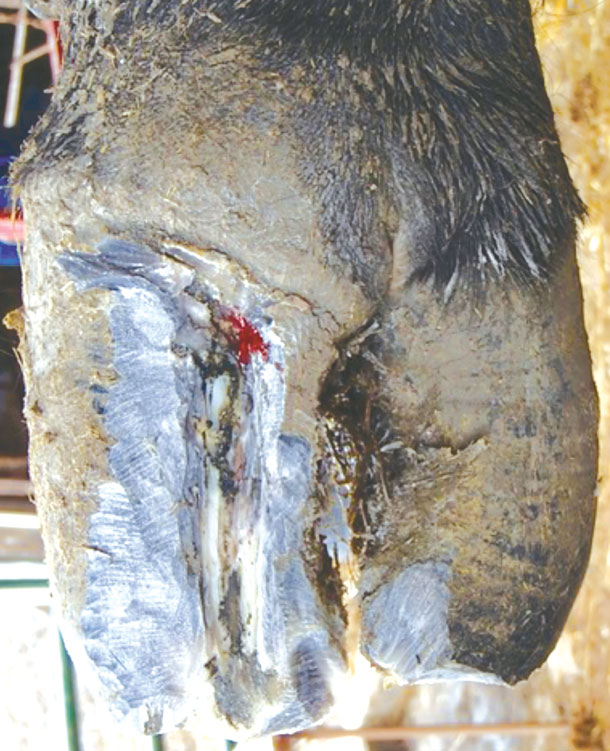
“If a vertical crack goes all the way to the coronet (splitting the outer part of the claw in two), there could be movement between those two pieces, and the wall is unstable. It’s difficult to stabilize those. A thin block under the fractured claw can help hold it together with a thicker block under the healthy claw to carry the weight,” says Shearer.
Another strategy is to wire the two pieces together. “We may also use hoof glue to stabilize the wall. A vertical crack associated with white-line disease often results in damage to the underlying corium, and we can’t get good hoof horn to form over that area again. These can become chronic conditions,” he says.
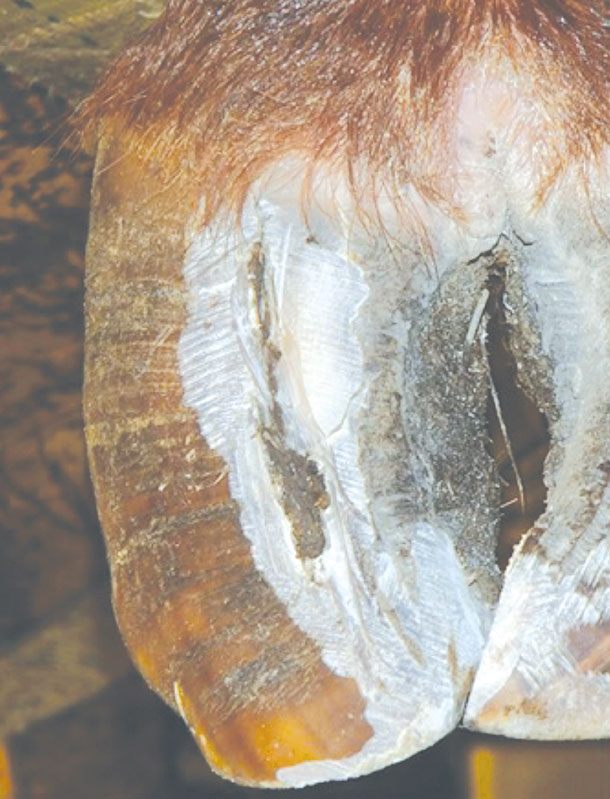
When dealing with wall cracks (vertical or horizontal), trimming can be helpful. “Some feet need trimming on a regular basis – especially cattle affected with screw claw,” says Shearer.
Screw claw
“Abnormal growth at the toe and twisting of the claw may cause the animal to bear weight on the side of the foot instead of the sole. The lateral wall folds underneath,” Shearer says.
“There seems to be a genetic tendency, so it’s unwise to use severely affected animals for breeding. Other factors that contribute to screw claw are previous bouts of laminitis, excess bodyweight, housing/environmental conditions and advancing age.
When observed at an early age, there may be a genetic link. Most commonly affected are the outer claws on the rear feet and sometimes the inner claw on the front feet,” he says. ![]()
PHOTO 1: Horizontal cracks growing out and coming loose on both front feet.
PHOTO 2: Foot rot, with swollen necrotic tissue between the toes. Photo provided by Andrew Niehaus.
PHOTO 3 & 4: White-line disease starts at the bottom of the foot with a separation at the sole and works its way upward under the horn, sometimes surfacing near the coronary band.
PHOTO 5 & 6: To resolve white-line disease, the loose horn is removed and the eroded tissue is trimmed away to open it to the air – while pressure is removed from the diseased claw with a glued-on clog under the sound claw.
PHOTO 7: This vertical crack has been trimmed.
PHOTO 8: This crack goes clear to the coronary band. Photos provided by Jan Shearer.
Heather Thomas is a freelance writer based in Idaho.







